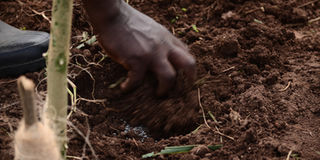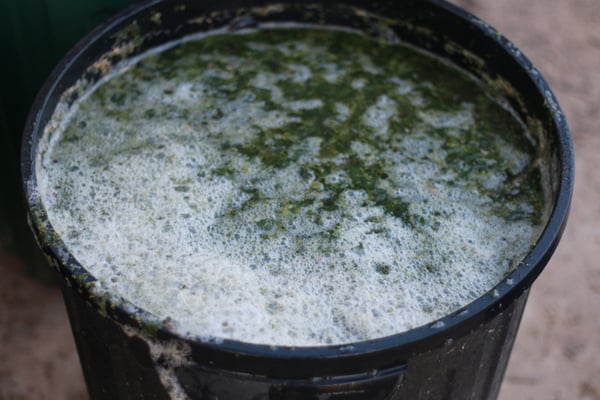Prime
High fertiliser prices force farmers to rethink

A technician at Namulonge applies basal fertiliser in a demonstration maize garden. Photo / George Katongole
What you need to know:
- Stakeholders meeting at Golf Course Hotel to find ways of mitigating the high prices of fertilisers, it was agreed that government subsidies are the only option for farmers ahead of the planting season.
Fertiliser prices have more than doubled since the start of 2022, following last year’s surge while experts fear that food production will go down warning predicting famine.
Stakeholders meeting at Golf Course Hotel to find ways of mitigating the high prices of fertilisers, it was agreed that government subsidies are the only option for farmers ahead of the planting season.
The event was organised by the African Fertiliser and Agribusiness Partnership and the Ministry of Agriculture Animal Industries and Fisheries (Maaif).
Joel Kakaire, the Country Manager of AFAP notes that skyrocketing fertiliser prices in the country are threatening food security. “The fertiliser crisis will hit the farmers hard. We doubt whether the market is ready for the high fertiliser prices. With maize grain at Shs2,000 currently, a hunger crisis looms,” Kakaire warns.
Push factors
The soaring prices are driven by numerous factors, including surging input costs, supply disruptions caused by sanctions in Belarus and Russia, and export restrictions in China.
“It is a difficult situation one we have never seen before. If nothing is done, it might get worse,” said Sophie Mirembe, the head of commercial at Grain Pulse.
Grain Pulse, an agro-centric company provides sustainable solutions for smallholder farmers. It has a fertiliser blending plant in Mukono District with a capacity of 300,000 metric tonnes
“Currently we are holding more than 10,000 tonnes worth of stock ahead of the season. The smallholder farmers, who are our target will not be able to afford the fertilisers because of pricing,” Mirembe says.
Prices for raw materials that make up the crop nutrient commodity market ammonia, nitrogen, potash, urea, phosphates, sulphates and nitrates have risen since the start of the year, and are now higher than the levels reached during the Covid-19 pandemic.
Mirembe says that last year during the pandemic, the prices of raw materials rose to between 50-60 per cent but now Muriate of Potash (MOP) has now doubled. Mirembe says that they used to buy MOP at $400 (Shs1.5m) but now it is at $1,112 (Shs4m).
Fertiliser blending provides a solution to farmers to have the correct ratio of nitrogen, phosphorous, potash, and micro nutrients. Fertiliser blending is often the best solution to provide farmers exactly what their crops require.
Urea prices have surpassed their 2019 peaks, while phosphates and potash prices are sky high already. Concerns around fertiliser affordability and availability have been amplified by the war in Ukraine.
Russia accounts for about 16 per cent of global urea exports and 12 per cent of DAP and MAP exports, while Russia and Belarus together make up two-fifths of global MOP exports. Adding to supply concerns, China has suspended exports of fertilisers until at least June 2022 to ensure domestic availability.
Gilbert Kato from Export Trading Company (ETG), notes that for instance, a 50kg bag of Diammonium phosphate (DAP), the most widely used phosphorus fertiliser used to buy Shs93,000 before the covid-19 pandemic. Last year, a 50kg bag was sold at Shs150,000 yet current prices are Shs195,000.
Although in Uganda fertiliser use remains low at 3.3 kilogrammes per hectare as in 2018, the low-income farmers, who constitute 85 per cent of the farming community, need fertiliser too.
Farmers’ concern
Soaring prices are causing farmers to adjust their planting strategies. They are also driving interest in alternatives to conventional fertilisers.
James Mulwana, a mixed farmer in Nakifuma is preparing his gardens for the planting season. His main cash crop, tomatoes, are already thriving. But he is concerned the increasing fertiliser prices will affect his production.
Mulwana says that fertilisers take up to 40-45 per cent of his costs of production with the other budget going to labour and seed. “Fertilisers are central to my farm operations,” says Mulwana, who mainly grows passion fruits, tomatoes, maize and bananas on his seven-acre farm. “Last season I tried to use less of fertiliser but I ended up with a poor harvest. I used three bags of conventional fertilisers and complemented it with manure,” he says.
He normally buys NPK, SSP, Urea and foliar fertilisers on top of using chicken litter. A bag of litter, he says, costs him about Shs15,000. To cater for an acre, one may need about 8-10 bags. This season, he plans to use 250 kilogrammes of manure for a proper harvest.
“In this period, chemical fertilisers are the best option because litter needs rain,” he said.
Subsidies
Although the Minister of State for Agriculture Fred Bwino Kyakulaga did not provide an immediate solution during the summit, farmers who depend on chemical fertilisers are asking for subsidies. “We need subsidies to farmers to be able to afford the fertilisers,” Mirembe suggests. She opines that through the Parish Development Model, farmers’ needs can be addressed for an immediate intervention.
Maaif previously ran the Agriculture Cluster Development Project (ACDP), an e-subsidy programme. But the suppliers are yet to be paid. With high grain prices, organic alternatives are also in short supply while they need a long time to prepare. Dr Cranmer Kawuki Kayizzi, a soil scientist at Kawanda-based National Agriculture Research Laboratories (NaRL), believes that farmers now need to find sustainable options.
Dr Kayizzi says Nitrogen, Phosphorus and Potassium, the three major plant nutrients required for bumper harvests and nutritious foods are being fast depleted at the rate of 21kg, 8kg and 43kg per hectare per year, respectively.
Dr Kayizzi says that a measured approach is to use soil testing to cut back on fertiliser use.




